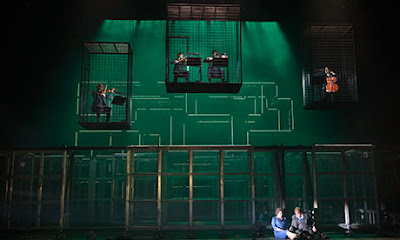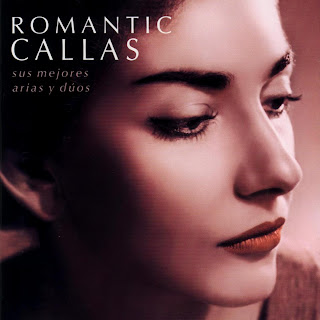Go Abstract, Just Go All the Way: Beethoven's Fidelio at the English National Opera
Having seen film versions of Beethoven's Fidelio and seen it live in Vienna in a fairly traditional if not period-specific production I was intrigued by the abstract production being offered at the English National Opera. I have no problem with abstract productions but I do tend to think it is easier to do more traditional productions well, or at least acceptably, whereas the bar is higher for abstract productions. Oddly, therefore, I was surprised to find that this production of Fidelio would have been more pleasing had it actually played on its abstract strengths rather than going to those extremes only at certain moments and falling into complacency between them. This review will be a bit unusual in that I will touch on the performers first before the production, almost in opposite order of my normal order.
Synopsis and general information: http://en.wikipedia.org/wiki/Fidelio
Fidelio | Ludwig van Beethoven
Credits:
Director | Calixto Bieito
Set Designer | Rebecca Ringst
Costume Designer | Ingo Krügler
Lighting Designer | Tim Mitchell
Translator | David Pountney
Violin | Cerys Jones
Viola | Gary Pomeroy
Cello | Christopher Murray
Synopsis and general information: http://en.wikipedia.org/wiki/Fidelio
Fidelio | Ludwig van Beethoven
Credits:
Director | Calixto Bieito
Set Designer | Rebecca Ringst
Costume Designer | Ingo Krügler
Lighting Designer | Tim Mitchell
Translator | David Pountney
Performers:
Leonore | Emma Bell
Florestan | Bryan Register
Rocco | James Creswell
Florestan | Bryan Register
Rocco | James Creswell
Don Pizarro | Philip Horst
Marzelline | Sarah Tynan
Jaquino | Adrian Dwyer
Don Fernando | Roland Wood
Marzelline | Sarah Tynan
Jaquino | Adrian Dwyer
Don Fernando | Roland Wood
Conductor | Edward Gardner
Quartet:
Violin | Oliver Heath Violin | Cerys Jones
Viola | Gary Pomeroy
Cello | Christopher Murray
_________________________________________________________________________
Emma Bell, as Leonore, is of course the focus of the show as her Fidelio goes undercover to rescue Florestan from his political imprisonment. Her background, especially in Baroque and Mozartean roles, is interesting given she also has fairly extensive performance credits building up in Puccini, Verdi, and now Wagner (to which Fidelio is almost like a strange vestigial appendage). Bell's voice was vibrant and resonate. Almost surprisingly, it lacked a tone that spoke openly of squillo, as many voices of her type might. Rather, the voice held a sort of resonant depth. This was fitting for the role of Leonore, giving a sense of resolve, making her disguise as a man plausible, and leaving the climax convincing. Her voice never lost its essentially classical feel, a sort of mellow warmth, which definitely was a contrast to the many Wagnerians who play the role, especially in "Abscheulicher! wo eilst du hin?...Komm, Hoffnung, lass den letzten Stern," which was evocatively sung. As will be discussed, this production dictates a lot of the acting. Still, within the confines of the production Bell might have been able to bring out more warmth, a bit more passion and tenderness. Though she seemed convincingly in character, it was hard to believe strongly in the story of the impassioned wife rescuing her lover because of a lack of love itself. Bell is certainly a performer to bear in mind and the shifts she is making in repertoire may well lead to very impressive performances, so long as she can find some affection!
Stuart Skelton was unfortunately indisposed the night of my performance. He had won some acclaim for his performance in this production and his portrayal of Florestan generally. Bryan Register, who played the character for part of the run, stepped in at the last minute. Register was initially quite thrilling in "Gott! welch' Dunkel hier!"with a large, thrilling tone and secure, easy command of the notes. Immediately, though, this impressive beginning gave way to pushed out high notes and obvious strain under the demands of the difficult role. These plagued Register less later in the opera, but the occasional wobble in the voice became more apparent and lost the pleasing consistency with which it initially began. Register's interactions with Bell were just as cold as Bell's (of course a mutually reinforcing problem). In his role as a prisoner, however, he was much more pleasing, offering real despair and resignation initially and a true renewed wonder and lust for life after his release.
As Rocco, James Creswell offered the most nuanced, consistent, and touching performance of the evening. His velvety baritone voice never showed a hint of strain, always moving easily from note to note and allowing the character to come to the fore, a beautiful factor apparent in "Hat man nicht auch Gold beineben" and throughout. He adeptly demonstrated the progression of a man living in his own world who, though not without morales, doesn't question the duties of his distasteful job to a man plagued by anxiety over the acts he performs for Don Pizarro as he becomes more tender toward the other prisoners and to Florestan under the subtle manipulation of Leonore. Creswell was a gem among rough, unfinished semi-precious stones.
Philip Horst was plagued by inconsistency as Don Pizarro. In general the voice felt lacking in freedom and a bit like a loose cannon suffering from a bit of rust. In "Ha! welch' ein Augenblick!," however, his explosive fury was breathtaking, giving a suddenly convincing shove to the characterization and demonstrating the true villainy of Don Pizarro. It was unfortunate that Horst could not bring the same fiery vocality and engaged acting to the rest of the role.
Looking at the rest of the ensemble, including Sarah Tynan's Marzelline, unfortunately the performances were unremarkable. Again, the production may be to blame in part, especially in the case of Tynan's Marzelline, who was so invisible I admit I have basically forgotten the performance. Meanwhile, Roland Wood in the role of Don Fernando was so crippled by the staging that it was impossible to tell the quality of or even really pay attention to his voice and skill as a performer. The chorus, somewhat smaller than it might have been, lacked the staying power and clear characterization possible but got the job done.
Edward Gardner and the orchestra played fine through the work, although the classical style perhaps was problematical and lead to some inconsistency. It was very interesting to hear this more classical take on the opera, give how it is so often reverse-influenced by Wagnerian concepts and blown far out of the proportions in which Beethoven might have expected it to be played. Some of the problems for the orchestra came from the production itself, not unlike everything else. The quartet playing Adagio from Op. 132 was a highlight of the show and performed with a searing beauty enhanced by their suspended imprisonment in cages above the set. These soloists perhaps outclassed any performer, singer or orchestra, in the rest of the production, creating an odd inequality on which I will touch shortly.
The real problems with this production lie in the production both due to the set, costume, and lighting design by Rebecca Ringst, Ingo Krügler, and Tim Mitchell, respectively and also due to the direction of Calixto Bieito, who was apparently not particularly present. The problems begin with the basic manipulation of the opera itself. Though I understand why the ENO performs its operas mostly in English, I do believe some of the poetry is lost. I personally prefer surtitles, regrettable as they can be, to translation. Beyond this, however, the translation and arrangement of the dialogue was completely unnatural, changed much of the text, referenced random, irrelevant texts, and cut not only a significant amount, but also significant moments, such as the moment of recognition in the dungeon. The sung text was more preserved but also poorly translated. If so much reworking and rewriting had occurred and worked, the betrayal of Beethoven might be sustained. As it was it made the opera unintelligible and robbed it of much of both its pathos and thoughtfulness. On top of this, the substitution of Leonore No. 3 for the standard overture, a choice Beethoven rejected, and the inclusion of a manipulated Adagio from Op. 132 after the love duet further fragmented the work and robbed it of its original flow. (Yes the former is sometimes played where the latter was but that practice is itself of questionable usefulness and this was certainly overkill, especially given the revelatory, all-inclusive nature of Leonore No. 3.)
The costuming for the production was fine though uninteresting, a kind of unspecific 20th-century garb. The biggest problem was that it made it very difficult to differentiate and track characters in the massive, tangled set. It was not offensive in any way but did not add to the interpretation and undermined audience understanding. The set has been the subject of much debate. It is certainly a technical marvel, with moving labyrinthine towers composed of tubelike lit segments and clear walls, floors and ceilings. The most impressive aspect, technically, is the way the set then rolls down to create an actual labyrinth on the ground horizontally rather than vertically. Though it is true that the strobe-like reflecting light at the beginning was blinding and at times the lighting did not seem to correlate in any intelligible way to the action on stage, the set was not the root of this production's problems as one might assume. It absolutely represents, in very abstract terms, a prison and the winding path of life. It certainly also brings visual interest. Rather, the problem lies with the use of it.
Bieito had the opportunity to take Fidelio in a a highly abstract direction given the set and the performers he had available. As so often happens, however, with abstract productions, the result was instead the middle ground. The most evocative, thought-provoking moments of the production were when people were crawling all over the structure during Leonore No. 3 (as inappropriate a musical selection as that might be) and while slow, almost post-orgasmic action occurred with Leonore and Florestan changing during the Adagio from Op. 132. In the former, the nature of imprisonment, the frantic scramble through a labyrinth, the livelihood of a prisoner, and more general commentary on human nature were all present, if abstract. In the latter, the contentment of love, the exhaustion of an explosive night, and the resolution of injustice were also all portrayed while the love that the leads failed to portray poured forth from the orchestra. For the rest of the production, however, singers generally either stood in or on portions of the set or, for a shocking amount of time, out in front of it. They interacted as normal singers do, except devoid of many of the emotions we would expect. This gave a stiffness to the performance and crippled its believability. Had Bieito only chosen to take the entire production in a more abstract direction, it could have been gripping and thought-provoking. The nail in the coffin, so to speak, was the appearance of Don Fernando in 18th-century regalia from the royal box in the opera house, speaking peace but shooting Florestan, who quickly revived under the able hands of Leonore. Having recently studied use of similar costuming in the somewhat theoretical performance of Vinci's Artaserse in Köln, that kind of costuming can work even out of period. Here it was fatal and totally out of place, adding a campy, kitschy, completely inappropriate tone to a serious, thoughtful work. The shot at Florestan might have meant something had he truly died. As it bared fazed him it was extremely hard to understand why it happened and what was going on at that moment.
That shot, indeed, was not the shot that killed Florestan but the shot that finally killed this production of Beethoven's Fidelio.














Comments
Post a Comment